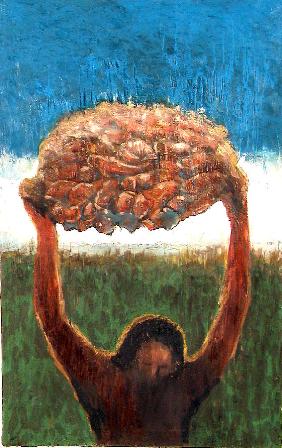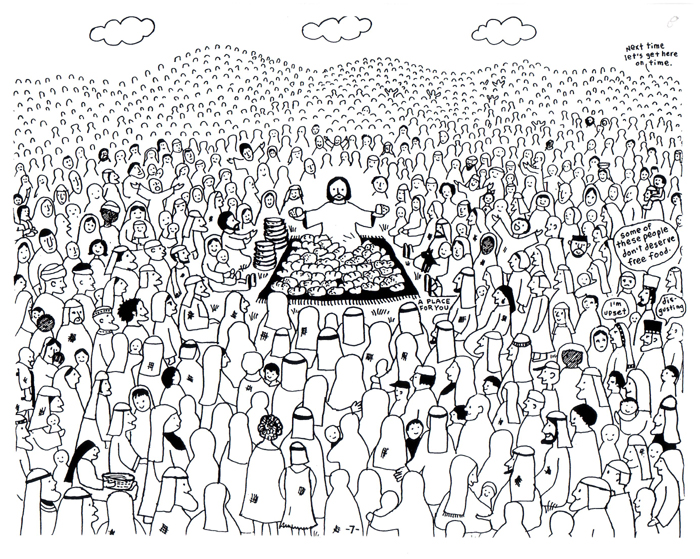I. Theme – Providing for each other out of our abundance

"Feeding of the 5,000" – Daniel Bonnell
The lectionary readings are here or individually:
Old Testament – 2 Kings 4:42-44
Psalm – Psalm 145:10-19 Page 802, BCP
Epistle –Ephesians 3:14-21
Gospel – John 6:1-21
How do we provide out of our abundance ? What is hunger ? In this week’s lectionary, multiplication of food given to Elisha demonstrates God’s power to provide abundantly in the Old Testament. Paul exhorts the Ephesians to use their spiritual gifts to build up the Body of Christ. Jesus multiplies five loaves and two fish to feed the hungry crowd. The feeding of the 5,000 is the only miracle of Jesus’ ministry recorded in all four gospels. As so often emphasized in John, Jesus takes the initiative, even before the people arrive.
Hunger is multidimensional. People are hungry not only for bread but also for dignity, meaning, and happiness. Thus, we might ask the same question Jesus did: “Where are we to buy bread for these people to eat?”
It’s a tricky question, as John implies with his parenthetical comment. The things which most satisfy our deepest hungers can’t be purchased. Still on the literal plane, Philip despairs: no amount of money could assuage the vast crowd’s hunger. (While they may well be physically hungry, remember that they followed him initially because of his compassion toward the sick.) Jesus’ silence directs us to look toward our own resources.
Faith is what helps us to understand the incomprehensible. Faith is what holds us to the path of God, the way of Christ. We are faced with temptations every day to live for ourselves, to satisfy our own greed and desires, and we forget the needs of others and God’s desire to live for others. In living for others, we find that we have life. In living for Christ, we find that we have lived for others. In thinking of the needs of others, we are reminded that we can be overwhelmed, as Elisha’s servant and Jesus’ disciples felt, or we can have faith, as Elisha and Jesus did, that the needs will be met when we serve and give out of what we have. It is not easy, but it is what we are called to do—and God always provides enough. We may not be able to solve the world’s hunger problems, but we can do our part to help those around us—and we may be surprised at what God can do with the little we have.
The child’s lunch box and the mother who probably packed it are a delightful reminder that “those who would be a blessing for others must bring what they possess to Jesus.” Without a scoff, a snicker or a doubt, Jesus takes the bread and fish into his hands with all confidence. Ignoring Andrew’s concern about scarcity, he provides an abundance. His action reassures those of us who deem our efforts too meager or skimpy to ever count as ministry, or to have any significant effect within God’s design. Instead we can count it, as did St. Ignatius of Loyola, “a toweringly wonderful thing that you might call me to follow you and stand with you.”
The miracle adds a new dimension to the picture of God given in Psalm 145. There, the people look hopefully to God as the source of their food. The opening of God’s hand satisfies their desires. In light of John’s gospel, we enter more directly into that process. No longer does God stand on one side of an abyss and we on the other. Now, Jesus takes our barley loaves into his hands and blesses them. In a co-creative act, we bring the food, share it with Jesus and each other, then gather the left-overs.
Those who are, as Ephesians calls us, one in body and spirit, cannot blame God for world hunger, neglected children and all our other social ills. For God has called us to partnership, graced our efforts, and made us abundant blessings for each other.
Read more












